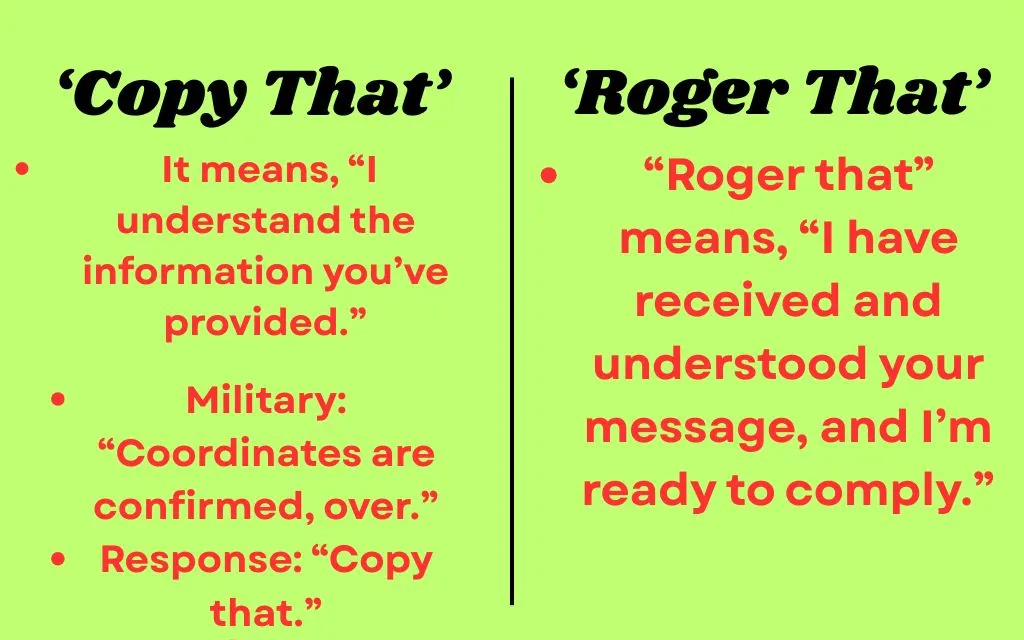Last updated on April 17th, 2025 at 07:26 am
Language evolves through necessity, and nowhere is this more evident than in military communication.
Two of the most commonly recognized phrases, “copy that” and “roger that,” have roots in structured radio communication but have since made their way into everyday conversations.
While these phrases often seem interchangeable, they carry distinct meanings and histories. This comprehensive guide explores the differences, origins, and uses of these iconic expressions.
Decoding Military Language: Origins and Usage

Military language is built around clarity and brevity. Misunderstanding commands in high-pressure environments can have serious consequences, which is why standardized communication systems, such as the NATO phonetic alphabet and radio jargon, were developed.
Both “copy that” and “roger that” originated in the military to confirm the receipt of a message. Over time, these phrases became staples of professional and casual communication.
However, their original contexts provide insight into their proper usage and nuances.
“Copy that” and “roger that” may seem similar, but they serve different purposes. Learn their origins, meanings, and when to use each effectively!
“Copy That”: Acknowledging Information in Communication
The phrase “copy that” comes from early radio transmissions, where clear acknowledgment of a message was crucial.
- Definition: It means, “I understand the information you’ve provided.”
- Origins: In radio communication, operators would respond with “copy” to confirm they had received the message verbatim. The term implies both receipt and comprehension of the transmitted details.
Example in Context:
- Military: “Coordinates are confirmed, over.”
Response: “Copy that.” - Civilian: “Can you pick up the groceries on your way home?”
Response: “Copy that.”
This phrase has since transcended its technical roots, becoming a casual way to acknowledge information in non-military settings.
The Role of “Copy That” in Modern Conversations
Today, “copy that” is widely used beyond the military. It’s common in workplaces, group projects, and even daily texting.
Why Is It So Popular?
- Clarity: It provides a direct acknowledgment without ambiguity.
- Efficiency: Short and to the point, it replaces longer confirmations like, “I’ve got it.”
- Cultural Influence: Its use in movies and TV shows has normalized it for everyday use.
Examples in Casual Use:
- Text: “The meeting is at 3 PM.”
Response: “Copy that!” - At work: “Please submit the report by end of day.”
Response: “Copy that, boss.”
How Hollywood and Video Games Popularized “Copy That”
The entertainment industry has played a significant role in embedding “copy that” into popular culture. From action-packed military movies to strategy-based video games, the phrase adds an element of authenticity to scripted dialogue.
Examples from Pop Culture:
- Movies:
Top Gun (1986) and other aviation-themed films feature characters frequently saying “copy that” in high-stakes situations. - Video Games:
Games like Call of Duty and Battlefield use the phrase in mission briefings and squad interactions.
These mediums have helped the phrase shed its technical roots, turning it into a shorthand for acknowledgment that anyone can use.
The Transformation from Morse Code to Everyday Speech
The journey of “copy that” from military jargon to casual speech involves advancements in communication technology.
- Morse Code Era: In early radio transmissions, operators relied on Morse code to send messages. Acknowledging receipt was critical, and “copy” became the shorthand for confirmation.
- Voice Communication: As technology advanced, verbal communication replaced Morse code, and terms like “copy” became verbalized for clarity.
- Mainstream Usage: With the rise of mass media and cultural exchanges, the phrase found its way into the civilian lexicon.
The Action-Oriented Nature of “Roger That”
Unlike “copy that,” which focuses on understanding, “roger that” emphasizes acknowledgment and readiness to act.
- Definition: “Roger that” means, “I have received and understood your message, and I’m ready to comply.”
- Origins: The term “roger” originates from the phonetic alphabet used by the military in the 1940s. “R” (for “received”) was pronounced as “roger” to confirm receipt of a message.
Key Difference:
While “copy that” confirms understanding, “roger that” implies both understanding and agreement to take action.
Example in Context:
- Military: “Proceed to the rendezvous point at 1400 hours.”
Response: “Roger that.” - Civilian: “Make sure to finish the presentation by tomorrow.”
Response: “Roger that, will do.”
Understanding the Context: When to Use Each Phrase
When to Use “Copy That”:
- To confirm receipt of information.
- When no further action is immediately required.
- In casual, professional, or technical contexts.
Example:
“The package will arrive at 5 PM.”
Response: “Copy that.”
When to Use “Roger That”:
- To confirm receipt and readiness to act.
- In situations where compliance or follow-up is implied.
Example:
“Make sure to secure the perimeter before nightfall.”
Response: “Roger that.”
Interchangeability and Misconceptions in Civilian Talk
Though “copy that” and “roger that” are often used interchangeably in civilian conversations, they are not identical in meaning.
Common Misconceptions:
- “Copy that” and “roger that” both imply action. (Incorrect)
- They are purely military phrases. (Incorrect)
Reality:
- Use “copy that” when no action is required.
- Use “roger that” to confirm both understanding and willingness to comply.
The Nuances of Agreement and Compliance in the Military
In the military, clarity of communication is paramount. Misusing “copy that” or “roger that” can lead to confusion or mistakes.
- Hierarchy Matters: Responses must align with the chain of command.
- Precision Over Politeness: Brevity and accuracy are valued over elaborate responses.
Key Takeaway: Roger that signifies an added layer of compliance compared to copy that.
From Aeronautics to Everywhere: The Cultural Journey of Radio Lingo
The use of “roger” and “copy” originated in military aviation but has since spread to other fields, including law enforcement, emergency services, and even casual settings.
Fields Where These Terms Are Common:
| Field | Usage Example |
|---|---|
| Aviation | “Roger that, cleared for takeoff.” |
| Law Enforcement | “Suspect is heading west. Copy that.” |
| Emergency Services | “The ambulance is en route. Roger that.” |
The widespread adoption of these phrases highlights their versatility and enduring relevance.
FAQs
What does “copy that” mean?
“Copy that” means, “I understand the information you’ve provided.” It confirms receipt and comprehension of a message without implying action.
What does “roger that” mean?
“Roger that” means, “I’ve received and understood your message, and I’m ready to comply.” It confirms both understanding and intent to act.
Can “copy that” and “roger that” be used interchangeably?
Not always. Use “copy that” to confirm receipt of information, and “roger that” when readiness to act is implied.
Why does “roger” mean received?
“Roger” originates from the 1940s phonetic alphabet, where “R” stood for “received.” It was used to confirm receipt of messages in military communication.
How did “copy that” and “roger that” enter pop culture?
Movies, TV shows, and video games like Top Gun and Call of Duty helped popularize these phrases, embedding them into everyday language.
Conclusion
While “copy that” and “roger that” share similarities in their origins, they serve distinct purposes in communication.
Whether you’re confirming receipt of information or indicating readiness to act, knowing when to use each phrase ensures clear and effective communication.
So next time someone gives you instructions or shares critical information, ask yourself: Am I simply acknowledging this, or am I ready to act? The answer will help you decide whether to say “copy that” or “roger that.”





